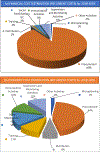Program cost analysis of influenza vaccination of health care workers in Albania
- PMID: 31669063
- PMCID: PMC10621071
- DOI: 10.1016/j.vaccine.2019.10.027
Program cost analysis of influenza vaccination of health care workers in Albania
Abstract
Background: Since 2012, WHO has recommended influenza vaccination for health care workers (HCWs), which has different costs than routine infant immunization; however, few cost estimates exist from low- and middle-income countries. Albania, a middle-income country, has self-procured influenza vaccine for some HCWs since 2014, supplemented by vaccine donations since 2016 through the Partnership for Influenza Vaccine Introduction (PIVI). We conducted a cost analysis of HCW influenza vaccination in Albania to inform scale-up and sustainability decisions.
Methods: We used the WHO's Seasonal Influenza Immunization Costing Tool (SIICT) micro-costing approach to estimate incremental costs from the government perspective of facility-based vaccination of HCWs in Albania with trivalent inactivated influenza vaccine for the 2018-19 season based on 2016-17 season data from administrative records, key informant consultations, and a convenience sample of site visits. Scenario analyses varied coverage, vaccine presentation, and vaccine prices.
Results: In the baseline scenario, 13,377 HCWs (70% of eligible HCWs) would be vaccinated at an incremental financial cost of US$61,296 and economic cost of US$161,639. Vaccine and vaccination supplies represented the largest share of financial (89%) and economic costs (44%). Per vaccinated HCW financial cost was US$4.58 and economic cost was US$12.08 including vaccine and vaccination supplies (US$0.49 and US$6.76 respectively without vaccine and vaccination supplies). Scenarios with higher coverage, pre-filled syringes, and higher vaccine prices increased total economic and financial costs, although the economic cost per HCW vaccinated decreased with higher coverage as some costs were spread over more HCWs. Across all scenarios, economic costs were <0.07% of Albania's estimated government health expenditure, and <5.07% of Albania's estimated immunization program economic costs.
Conclusions: Cost estimates can help inform decisions about scaling up influenza vaccination for HCWs and other risk groups.
Keywords: Cost analysis; Economic evaluation; Health care workers; Influenza; Low- and middle-income countries.
Published by Elsevier Ltd.
Conflict of interest statement
Declaration of Competing Interest
The authors declare that they have no known competing financial interests or personal relationships that could have appeared to influence the work reported in this paper.
Figures

References
-
- World Health Organization. Meeting of the Strategic Advisory Group of Experts on immunization, April 2012 – conclusions and recommendations. Wkly Epidemiol Rec 2012;87(21):201–16. - PubMed
-
- Neuzil KM et al. Data and product needs for influenza immunization programs in low- and middle-income countries: Rationale and main conclusions of the WHO preferred product characteristics for next-generation influenza vaccines. Vaccine 2017;35(43):5734–7. - PubMed
-
- Peasah SK et al. Influenza cost and cost-effectiveness studies globally – A review. Vaccine 2013;31:5339–48. - PubMed
Publication types
MeSH terms
Substances
Grants and funding
LinkOut - more resources
Full Text Sources
Medical

